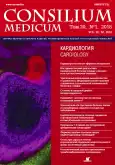Framework for management and controversial aspects of principal supraventricular tachycardia types pharmacotherapy
- Authors: Bunin Y.A1, Miklishanskaya S.V1
-
Affiliations:
- Russian Medical Academy of Continuous Professional Education of the Ministry of Health of the Russian Federation
- Issue: Vol 20, No 1 (2018)
- Pages: 71-78
- Section: Articles
- URL: https://journals.rcsi.science/2075-1753/article/view/95025
- DOI: https://doi.org/10.26442/2075-1753_2018.1.71-78
- ID: 95025
Cite item
Full Text
Abstract
Full Text
##article.viewOnOriginalSite##About the authors
Yu. A Bunin
Russian Medical Academy of Continuous Professional Education of the Ministry of Health of the Russian Federationд-р мед. наук, проф. каф. кардиологии 125993, Russian Federation, Moscow, ul. Barrikadnaia, d. 2/1
S. V Miklishanskaya
Russian Medical Academy of Continuous Professional Education of the Ministry of Health of the Russian Federation
Email: kvant83@list.ru
канд. мед. наук, ассистент каф. кардиологии 125993, Russian Federation, Moscow, ul. Barrikadnaia, d. 2/1
References
- ACC/AHA/ESC guidelines for the management of patients with supraventricular arrhythmias-executive summary. Eur Heart J 2003; 24: 1857-97.
- ACC/AHA/HRS guidelines for the management adult patients with supraventricular tachycardia. Circulation 2015; http://circ.ahajournals.org/lookup/suppl/doi:10.1161
- European Heart Rhythm Association (EHRA) consensus document on the management of supraventricular arrhythmias, endorsed by Heart Rhythm Society (HRS), Asia-Pacific Heart Rhythm Society (APHRS) and Sociedad Latinoamericana de Estimulacion Cardiaca y Electrofisiologia (SOLAECE). Europace 2017; 19: 465-511.
- Orejarena L.A, Vidaillet H, De Stefano F. et al. Paroxysmal supraventricular tachycardia in the general population. J Am Coll Cardiol 1998; 31: 150-7.
- Goyal R, Zivin A, Souza J et al. Comparison of the ages of tachycardia onset in patients with atrioventricular nodal reentrant tachycardia and accessory pathway-mediated tachycardia. Am Heart J 1996; 132: 765-7.
- Lee S.H, Chen S.A, Wu T.J et al. Effects of pregnancy on first onset and symptoms of paroxysmal supraventricular tachycardia. Am J Cardiol 1995; 76: 675-8.
- Cain N, Irving C, Webber S et al. Natural history of Wolff-Parkinson-White syndrome diagnosed in childhood. Am J Cardiol 2013; 112: 961-5.
- Abe H, Nagatomo T, Kobayashi H et al. Neurohumoral and hemodynamic mechanisms of diuresis during atrioventricular nodal reentrant tachycardia. Pacing Clin Electrophysiol 1997; 20: 2783-8.
- Olgin J.E, Zipes D.P. Specific arrhythmias: diagnosis and treatment. In Braunwald E, Zipes D, Libby P, Bonow R. (eds). Heart disease. Saunders Company 2005; 803-63.
- Luber S, Brady W.J, Joyce T et al. Paroxysmal supraventricular tachycardia: outcome after EDcare. Am J Emerg Med 2001; 19: 40-2.
- Lim S.H, Anantharaman V, Teo W.S et al. Slow infusion of calcium channel blokers compared with intravenous adenosine in the emergency treatment of supraventricular tachycardia. Resuscitation 2009; 80: 523-8.
- Bigger J.T, Goldreyer B.N. The mechanism of paroxysmal supraventricular tachycardia in man. Circulation 1970; 42: 673-88.
- Dougherty A.H, Jackman W.M, Naccarelli G.V et al. Acute conversion of paroxysmal supraventricular tachycardia with intravenous diltiazem. Am J Cardiol 1992; 70: 587-92.
- Alboni P, Tomasi C, Menozzi C et al. Efficacy and safety of out-of-hospital self-administered single-dose oral drug treatment in the management of infrecuent, well-tolerated paroxysmal supraventricular tachycardia. J Am Coll Cardiol 2001; 37: 548-53.
- Winniford M.D, Fulton K.L, Hillis L.D. Long-term therapy of paroxysmal supraventricular tachycardia: a randomizet, double-blind of digoxin, propranolol and verapamil. Am J Cardiol 1984; 54: 1138-9.
- Ferguson J.D, Di Marco J.P. Contemporary management of paroxysmal supraventricular tachycardia. Circulation 2003; 107: 1096-9.
- Dorian P, Naccarelli G.V, Coumel P et al. A randomized comparison of flecainide versus verapamil in paroxysmal supraventricular tachycardia. Am J Cardiol 1996; 77: 89A-95A.
- Бунин Ю.А., Денисов О.Н., Федякина Л.Ф. Профилактическая антиаритмическая фармакотерапия частых пароксизмов фибрилляции предсердий и некоторых видов наджелудочковых тахикардий пропафеноном в сравнении с плацебо. Рос. кардиол. журн. 2010; 5: 77-82.
- Малахов В.И., Шугушев Х.Х. Механизмы действия и эффективность этацизина у больных с пароксизмальной атриовентрикулярной узловой реципрокной тахикардией. Кардиология. 1986; 4: 48-54.
- Pappone C, Vicedomini G, Manguso F et al. Wolff-Parkinson-White syndrome in the era of catheter ablation: insights from a registry of 2169 patients. Circulation 2014; 130: 811-9.
- American heart association guidelines for cardiopulmonary resustitation and emergency cardiovascular care. Circulation 2010; 122: S729-S767.
- Spector P, Reynolds M.R, Calkins H et al. Meta-analysis of ablation of atrial flutter and supraventricular tachycardia. Am J Cardiol 2009; 104: 671-77.
- Manolis A.S, Katsaros C, Cokkinos D.V. Electrophysiological and electropharmacological studies in pre-excitation syndromes. Eur Heart J 1992; 13: 1489-95.
- Chimienti M, Cullen M.T, Casadei G. Safety of flecainide versus propafenone for the long-term management of symptomatic paroxysmal supraventricular tachyarrhythmias. Eur Heart J 1995; 16: 1943-51.
- Бунин Ю.А. Диагностика и лечение тахиаритмий сердца. Гл. 6. М.: Медпрактика-М, 2011; с. 219-68.
Supplementary files






